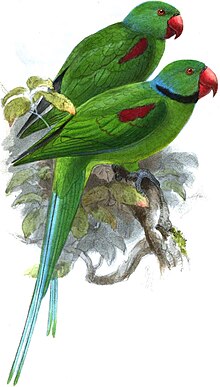| Seychelles parakeet | |
|---|---|

| |
| Illustration of a male (front) and female, by John Gerrard Keulemans, 1876 | |
| Scientific classification | |
| Domain: | Eukaryota |
| Kingdom: | Animalia |
| Phylum: | Chordata |
| Class: | Aves |
| Order: | Psittaciformes |
| Family: | Psittaculidae |
| Genus: | Psittacula |
| Species: | †P. wardi
|
| Binomial name | |
| †Psittacula wardi (Newton, E., 1867)
| |

| |
| Location of the Seychelles | |
| Synonyms | |
| |
The Seychelles parakeet or Seychelles Island parrot (Psittacula wardi) is an extinct species of parrot that was endemic to the Seychelles in the Indian Ocean. It was scientifically named Palaeornis wardi by the British ornithologist Edward Newton in 1867, and the specific name honours the British civil commissioner Swinburne Ward who procured the specimens that formed the basis for the description. It was found on the islands of Mahé, Silhouette, and possibly Praslin. Ten skin specimens exist today, but no skeletons. Though the species was later moved to the genus Psittacula, genetic studies have led some researchers to suggest it should belong in a reinstated Palaeornis along with the closely related Alexandrine parakeet (P. eupatria) of Asia.
This parakeet was about 41 cm (16 in) in length, with a long, pointed tail. The male was mainly green, with blue on parts of the head, and a black stripe on the cheek. The underside was yellowish, and the bird had a purple-red patch on the wings. The tail was blue, green, and yellow, and the bill was red and yellow. The female lacked the cheek-stripe, and the juvenile resembled the female. A single depiction from life is known, an 1883 painting by the British artist Marianne North. Little is known regarding the bird's habits, but they were presumably similar to those of the Alexandrine parakeet, associating in groups in forests, and making flights between communal roost sites and feeding areas. It lived in native forest, but adapted to cultivated areas as these were cleared, and its diet included fruit. Though abundant in 1811, it had become rare by 1867 because of human persecution for its perceived damage to crops. The last confirmed individual was shot in 1893, and no birds could be found by 1906.
- ^ BirdLife International (2012). "Palaeornis wardi". IUCN Red List of Threatened Species. 2012. Retrieved 26 November 2013.
